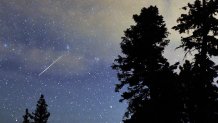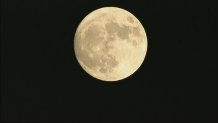Heads up stargazers, because shooting stars will be flying across the night sky this week.
The Perseid meteor shower, the most popular meteor shower, is active from July 7 to Aug. 24 with its peak happening on Friday and Saturday, with 50 to 100 meteors per hour flying through the sky, according to NASA.
They are best viewed in the Northern Hemisphere during pre dawn hours.
The Perseid meteors are particles that are released from the comet 109P/Swift-Tuttle during its returns to the solar system, according to the American Meteor Society. They are called Perseids since the radiant, which is the area of the sky where the meteors originate, is located near the prominent constellation of Perseum when at maximum activity.
Get top local stories in Southern California delivered to you every morning. Sign up for NBC LA's News Headlines newsletter.
As they streak through the earths atmosphere, Perseids generally leave long "wakes of light and color behind them creating a star-gazing experience.

This year, the Perseid showers will have to share the night sky with the final super moon of the year, the Sturgeon moon.
Local
Get Los Angeles's latest local news on crime, entertainment, weather, schools, COVID, cost of living and more. Here's your go-to source for today's LA news.
While it may be exciting to have two space objects gracing the night sky, the supermoon will impact how the meteor showers will look as the moon will brighten up the sky, and meteor showers need to fly through a dark sky to be viewed best.
Don't worry, we will break down the best times to see both the moon and the showers, but first what is a meteor shower anyway?
What is a meteor shower?
Typically, around 48.5 tons of meteoric material will fall on earth each day, according to NASA. However, the material is typically vaporized in Earth's atmosphere, which will leave a "bright fondly trail" which we know as shooting starts.
Often, several of these meteors or "shooting stars" can be seen on any night, and when the number increases dramatically, we have a meteor shower.
We see meteor showers annually as the Earth passes through the trail of dusty debris that is left by a comet.
Meteor showers are usually named after a star or constellation that is close to the meteor. The Perseids, which you will be looking out for this week, are the most famous meteor showers.
When and where can I watch the meteor shower?
The ideal time to catch any meteor shower would by with a dark sky, however, since the Sturgeon supermoon will be brightening up the night sky during the meteors' peak, it is best to catch the showers before or after their peak when the moon will become less bright.
The supermoon will reach it's peak on Thursday and will reach peak illumination at 6:36 p.m.
How can I watch the meteor shower?
Since meterors are best observed from dark wilderness locations that are away from city lights, the best way to watch the showers would be to travel to a wilderness area or campground with a dark sky. Most showers are strongest after midnight and until dawn, according to the Griffith Observatory.
While you can still see dimmed showers with the moon out, it is best to choose a night when the moon is not visible.
The Virtual Telescope Project will host a Perseid webcast on Tuesday to get more meteors before the brightness of the moon will dim the showers.
If you miss this shower, the next one will be the Orionids which will peak on Oct. 20 to 21.

What is the Sturgeon Supermoon?
The Sturgeon supermoon is the August full moon. It will reach it's peak illumination on Thursday.
The supermoon is the fourth of the summer and the final supermoon of the year, following the Strawberry and Buck moons.
This month's moon is called the Sturgeon moon because of the giant sturgeon fish of the Great Lakes and Lake Champlin that are most readily caught during this part of summer, according to The Old Farmers Almanac.
The moon will rise in Los Angeles on Aug. 11 at 8:04 p.m.



